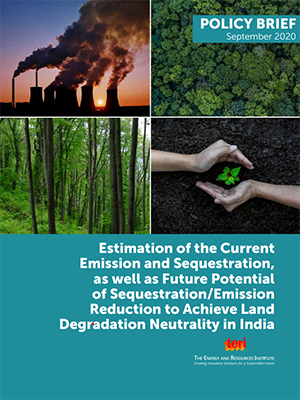Estimation of the current emission and sequestration, as well as future potential of sequestration/emission reduction to achieve land degradation neutrality in India
Understanding carbon sequestration potential of land use sectors is crucial for India to achieve its NDC target under forestry by 2030. This policy brief aims to do this by providing a detailed perspective on CO2 emission status of different land use sectors in India.

Land is a fundamental resource for preserving forests and biodiversity, food production, facilitating the natural management of water systems, and acting as a carbon store. Sustainability of these services, however, has been a challenge due to desertification, deforestation, loss of biodiversity along with climate change. In this regard, fostering land degradation neutrality by combating desertification and restoring the degraded land as outlined by Sustainable Development Goal 15 aims to protect and maximize the aforementioned services for the society.
Land Degradation Neutrality as defined by United Nations Convention for Combating Desertification refers to, "a state whereby the amount and quality of land resources necessary to support ecosystem functions and services and enhance food security, remain stable or increase within specified temporal and spatial scales and ecosystems".
As India targets achieving its Nationally Determined Contributions (NDC) to create additional carbon sink of 2.5 to 3.0 billion tonnes of CO2e through additional forest and tree cover by 2030, understanding carbon sequestration potential of different land use sectors becomes important.
Part of the six policy briefs launched during the World Sustainable Development Summit 2021, this aims to provide a more detailed perspective on CO2 emission status of India using major land use sectors which are forestry, animal husbandry, wetlands, mining and agriculture for the year 2019–2020 based on the latest available secondary data.

